New

Turn Your DMs Into Lead Gen!
Learn how to collect lead data from your DMs such as email addresses, phone numbers, and more right from your social inbox. If you are not yet automating your DMs your competitors are outpacing you.

How Something Social Saved 75% of Their Time and Increased Revenue by 15%
See how a fast-growing agency improved operations, cut down hours of manual work, and unlocked new revenue opportunities with Vista Social.
New

50 Unique Social Media Ideas for Consistent Content Creation
Discover 50 unique social media post ideas to engage your audience, grow your brand, and maintain a consistent content strategy with ease!

Mastering Content Reuse: The Key to a Consistent and Sustainable Posting Strategy
Published on September 18, 2025
12 min to read
Social Media Intelligence: Turning Data Into Actionable Insights
Summarize with AI
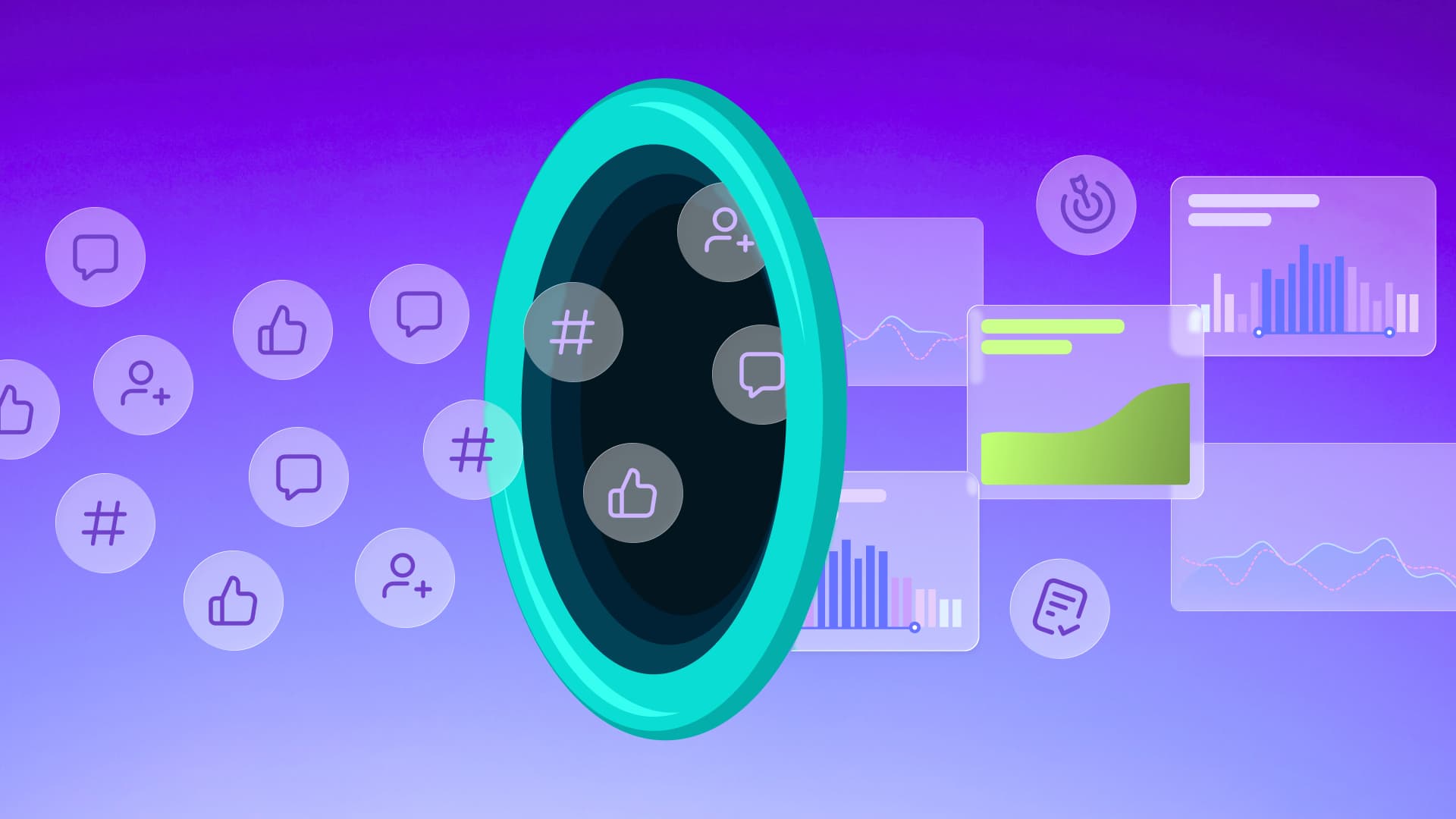

Table of Content

Social media is crowded and chaotic. Intelligence cuts through the noise.
Instead of stopping at likes and shares, social media intelligence transforms raw data into clear, actionable insights.
With the right tools, you can uncover audience behavior, monitor brand health, and predict campaign performance with accuracy and confidence.
You don’t just see what’s happening—you understand why it’s happening and how to respond.
This evolution from simple analytics to true intelligence empowers individuals, small businesses, and global organizations to make smarter, sharper moves online.
Table of contents
What is social media intelligence?
Social media intelligence is about gathering and analyzing data from your social platforms to make informed decisions. It’s not just about counting likes or impressions—it digs deeper into what your audience cares about, how they feel about your brand, and where new opportunities are hiding.
Businesses, entrepreneurs, and agencies use intelligence to move beyond surface-level numbers and toward true strategic value.
When you understand not just what’s happening but why it’s happening, you can build campaigns that connect more effectively. That clarity gives you the confidence to make decisions that drive real results, rather than relying on guesswork.
Why social media intelligence matters
Relying on instincts alone is a terrible idea. Social media moves too fast, and guessing your way through it almost always leads to wasted time and money.
With social media intelligence, you get clarity and speed. Instead of chasing hunches, you base your actions on real data. That makes a huge difference for businesses of all sizes:
- For growing businesses: It helps you spot customer sentiment early and pivot before small issues turn into big problems
- For teams and agencies: It provides data-backed reports that prove your recommendations and build trust with clients or stakeholders
- For creators and personal brands: It shows you exactly what’s working so you can double down on the content your audience actually loves
And the best part?
You don’t have to waste hours pulling reports by hand. With the right social media management tools, setting up automated reports can be accomplished in just a few clicks.
In Vista Social, for example, simply navigate to Reports and click Schedule Report.
A pop-up will appear, allowing you to set the report type, timeframe, generation date and time, recipients, and the email address of the report recipients.
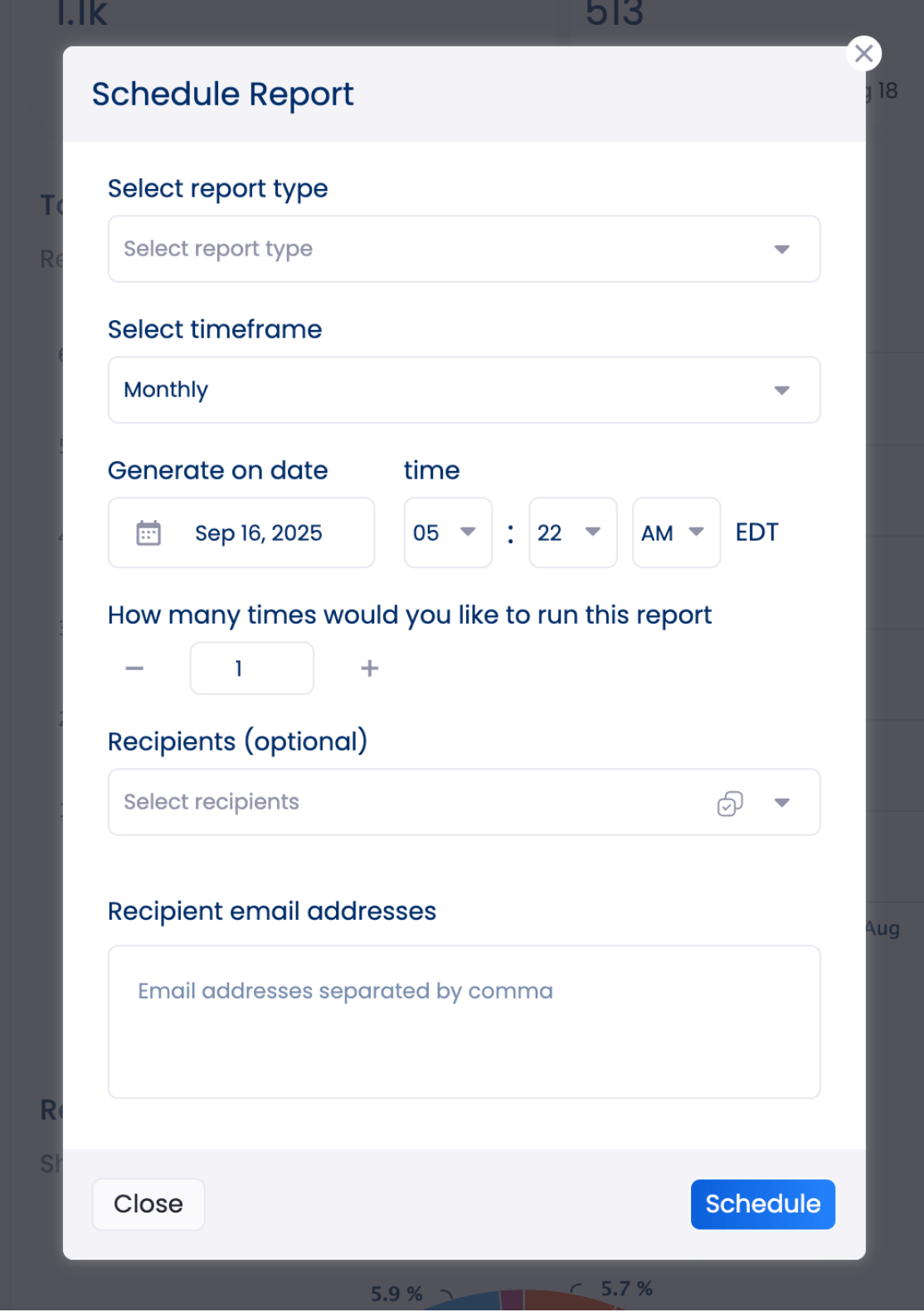
Once you’ve set everything up, Vista Social will automatically generate your reports at the exact date and time you scheduled—no extra effort required.
The best part is that Vista Social offers several report types for you to choose from. And with the Advanced plan, you can even customize your reports.
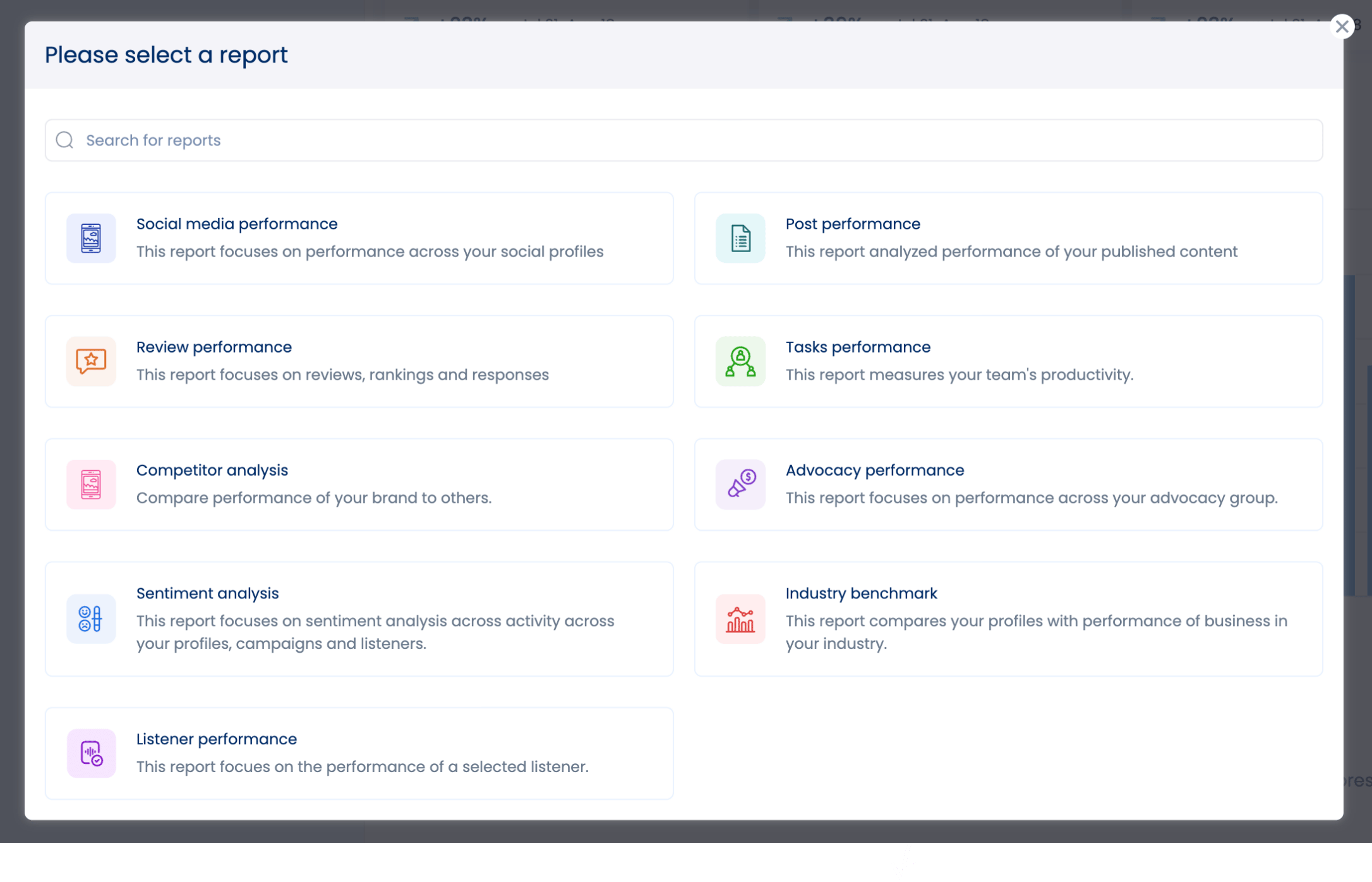
Automating reports will free you from the grind of working on spreadsheets for hours on end.
Instead of getting stuck formatting cells and crunching numbers, you’ll have more time to focus on planning, strategy, execution, and the work that actually moves the needle.
How social media intelligence supports the customer experience
Customer experience is now a competitive differentiator. People don’t just care about the product—they care about how brands treat them.
Social media intelligence bridges the gap between customer expectations and brand actions. By monitoring conversations and analyzing sentiment, you uncover hidden pain points before they escalate.
For example, if customers consistently complain about delayed shipping, intelligence highlights this trend quickly. That allows you to fix operational issues while also adjusting your messaging.
It also reveals moments where customers express delight, giving you opportunities to amplify positive feedback and strengthen loyalty. Patterns in customer questions can guide improvements to FAQs, tutorials, or even product design.
These insights reduce frustration while increasing satisfaction.
The result is a customer experience that feels seamless, responsive, and genuinely connected to audience needs. This proactive approach transforms customer experience from reactive problem-solving to proactive reputation building.
Customers feel heard, valued, and understood—three qualities that lead to stronger retention and referrals.
Must Read: Proven Strategies to Increase Customer Engagement on Social Media
Key components of social media intelligence
Once you understand the importance of social media intelligence and how it improves customer experience, the next step is knowing the key components that bring it to life.
Each component adds a layer of depth that guides stronger strategies and provides a more comprehensive picture of your social performance.
1. Audience insights
Audience insights show who engages with your content and why. By looking at demographics, interests, and behaviors, you can refine your targeting and create more personalized campaigns.
For example, if you discover your strongest engagement is coming from a younger audience segment, you ought to invest more in platforms like TikTok instead of Facebook.
2. Competitive benchmarking
But just knowing your audience isn’t enough. You also need to see how competitors are performing to identify gaps.
Benchmarking gives context for growth. If your competitors are outperforming you on engagement despite having a smaller following, that’s a signal to revisit your content strategy.
In situations like these, it pays to study the content pieces your competitors are publishing. Take note of their messaging, including whether they use videos, texts, images, etc.
3. Sentiment analysis
Competitor benchmarking naturally leads to sentiment analysis. After all, performance is not just about numbers—it’s also about how people feel about a brand.
Sentiment analysis gives you a health check on your brand’s reputation.
Positive sentiment often predicts loyalty and referrals, while negative sentiment indicates areas where improvement is needed.
4. Trend monitoring
Sentiment insights are directly tied to monitoring social trends.
If you know how audiences feel, you can predict which topics will gain traction.
By staying ahead of trending conversations, you can join discussions while they’re still growing. This often results in higher engagement and visibility because your content appears at the right time.
Common challenges in social media intelligence
While the benefits of social media intelligence are clear, it’s not without its challenges. Many teams stumble because they underestimate the complexity of turning raw data into insights.
There are several challenges teams can face:
- Data overload: Social platforms generate massive volumes of interactions daily. Without proper filters and dashboards, important information can get lost in the noise.
- Context bias: Numbers only tell part of the story. A spike in mentions could mean a viral success—or a PR crisis. Without proper sentiment analysis, you risk misinterpreting the data.
- Tool integration: Many organizations juggle separate apps for analytics, publishing, monitoring, and reporting. This fragmentation slows response times and increases the chance of missed insights.
- Lack of skilled analysts: Raw numbers require interpretation, and without trained eyes, valuable insights often go unnoticed.
- Real-time monitoring: Delays in spotting conversations can cost brands both revenue and reputation.
- Limited budgets: This can make it harder to invest in robust solutions. Even when the right tools are available, data silos between departments often prevent insights from being fully shared or acted upon.
- Measuring ROI: Tying social intelligence directly to revenue can be complex without a clear framework.
Turning social media intelligence into actionable reports
Knowing your audience, monitoring sentiment, benchmarking competitors, and identifying trends provide the raw materials for informed decision-making. Those insights only become useful when you package them into reports.
Reports consolidate individual pieces of intelligence into a clear, structured, and easy-to-share format.
Instead of scattered metrics across different platforms, you get a single, organized view of what’s working and where to adjust.
This is where social media intelligence begins to drive real impact.
Reports transform raw data into practical takeaways you can use to refine campaigns, prove ROI, and align your team or stakeholders around the same story. They bridge the gap between numbers and action.
Vista Social makes this process straightforward with various types of reports, each designed to highlight a specific layer of intelligence:
1. Social media performance report
This report gives you a bird’s-eye view of overall performance across your connected platforms.
It consolidates metrics such as reach, engagement, and follower growth, allowing you to see trends over time. It’s perfect for understanding whether your strategies are making a difference at a macro level.
Here’s a glimpse of the social media performance report.
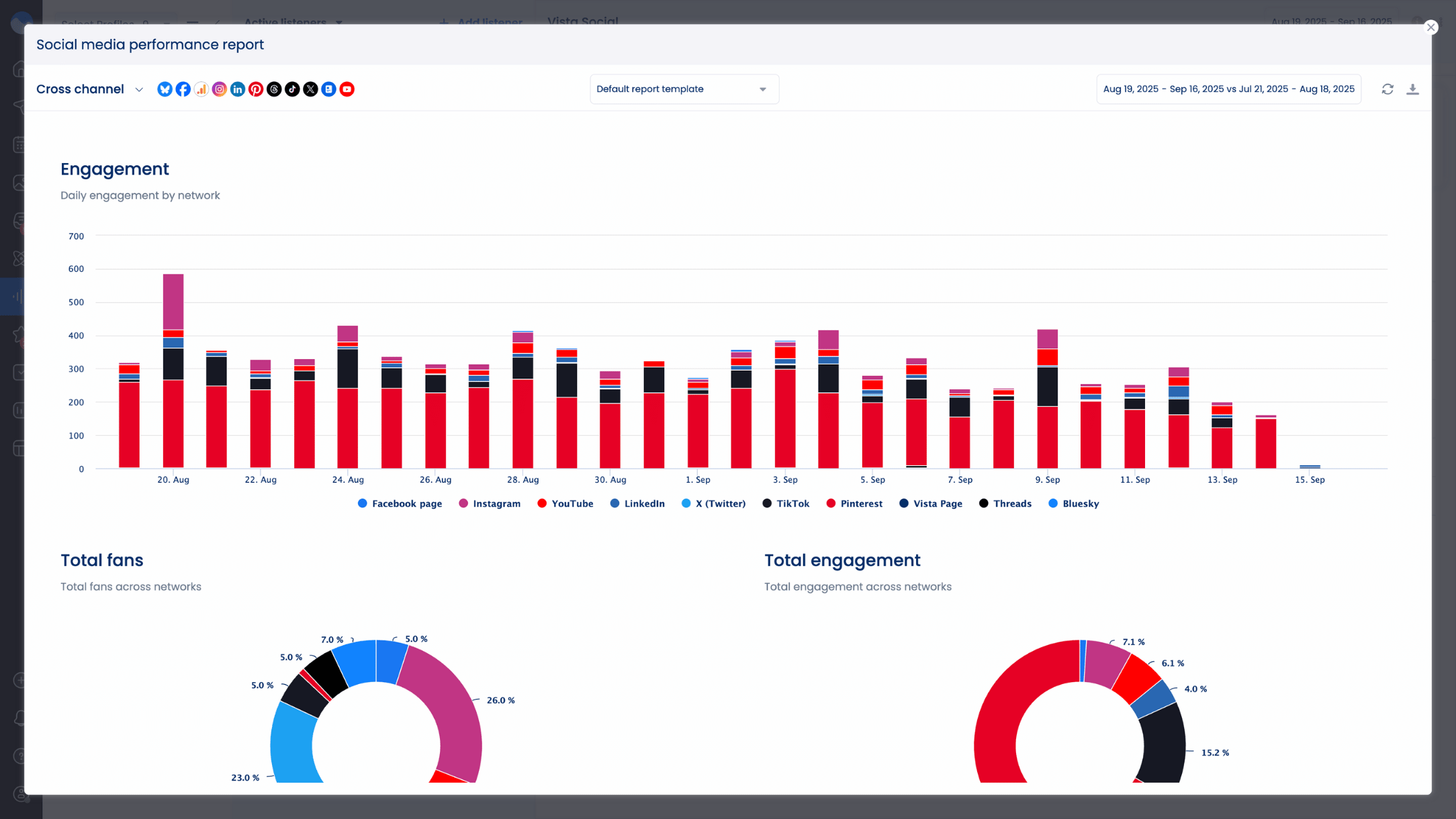
By observing and analyzing crucial data such as your daily engagement, you gain valuable insights into how your social media marketing campaigns are performing.
You can also see which posts are generating meaningful results. It becomes clear which social media platforms are bringing you the most visibility. With this information, you can make more informed decisions about which platforms to prioritize. You can also decide the type of posts you’ll create.
Finally, you’ll have a general view of which decisions are producing the best outcomes.
2. Post performance report
This report drills down into individual post performance. It shows which content types, formats, and publishing times drive the most interaction.
These insights help you fine-tune your content strategy and double down on what works best.
Some of the many data points you’ll see in this report are the impressions, engagement, engagement rate, etc.
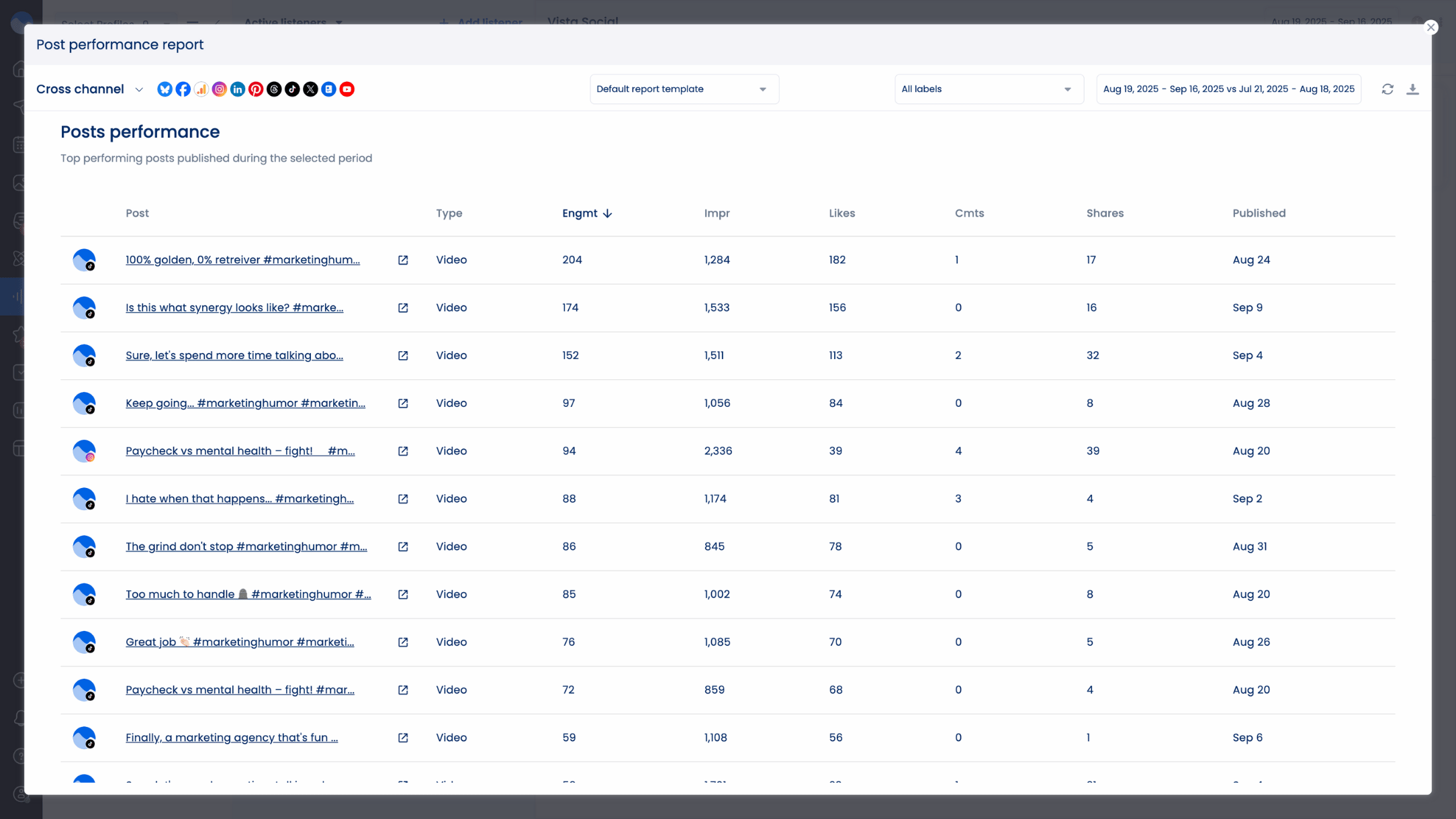
3. Sentiment analysis report
Vista Social’s sentiment analysis report shows how audiences feel about your brand by tagging interactions as positive, neutral, negative, or mixed. It tracks sentiment trends over time, highlights common themes, and gives you an overall sentiment score.
This helps you quickly spot issues, measure brand health, and understand what content drives positive reactions.
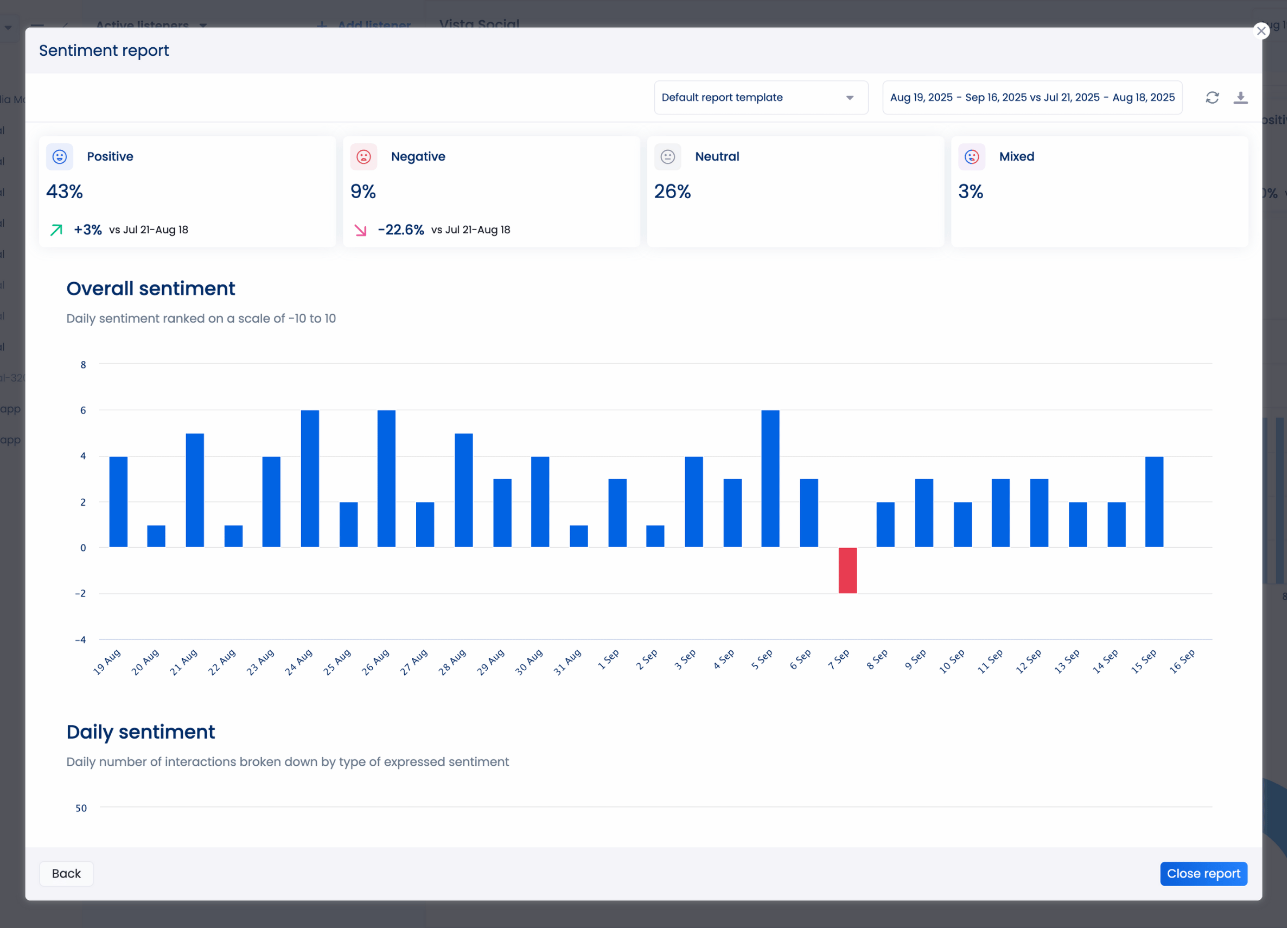
The three reports above are just a few of the many reports that Vista Social can generate. The platform can also generate reports for review of performance, competitor analysis, industry benchmarks, listener performance, and more.
The reports aren’t only for marketers—they’re equally valuable for executives, clients, and creators who need clarity without digging through raw data.
Automated updates make it easy to keep everyone aligned and focused on strategy, rather than spending time on manual reporting.
Think of it this way: social media intelligence provides the data, but reports transform that data into actionable stories. When used consistently, they help you move beyond tracking activity to making proactive, evidence-based decisions.
Best practices for social media intelligence reporting
Reports are only as valuable as the story they tell. Poorly structured reports overwhelm readers, while clear ones drive alignment and action.
These best practices can help you collect and analyze your social media intelligence data much more easily.
Start with your goals
Are you proving ROI to executives, or guiding content strategy for your team? Let the goal shape the metrics you highlight.
Try Vista Social for Free
A social media management platform that actually helps you grow with easy-to-use content planning, scheduling, engagement and analytics tools.
Get Started NowCombine quantitative and qualitative insights
Quantitative data (like numbers) show performance, but qualitative insights (like sentiment and context) explain the “why.”
For example, reporting that engagement increased by 20% is useful—but pairing it with sentiment trends makes the story far more actionable.
Automate where possible
Manually pulling metrics every week drains productivity. Instead, set up automated reporting in Vista Social. Choose your report type, timeframe, and audience, then let the platform deliver insights at the right cadence.
Use visuals
Charts, trend lines, and sentiment breakdowns convey information more effectively than raw tables. Vista Social’s reports are designed with clarity in mind, making them easier for non-technical stakeholders to digest.
Ultimately, the goal of reporting is to create alignment. Everyone—from executives to content creators—should understand what’s working, what’s not, and what to do next. That’s when social media intelligence becomes a true driver of growth.
Monitoring and responding to conversations
Social media intelligence isn’t just about numbers—it’s also about conversations. Monitoring what people say helps you protect and grow your reputation.
When you respond quickly to mentions, you show customers that you value them. It also helps prevent small issues from turning into full-blown crises.
Here’s how to stay on top of conversations using Vista Social.
Step 1: Open the Listening tab and click “Add listener.” Choose the type of listener you’d like to set up, whether one that will monitor your social media profiles for comments and messages, or a listener that monitors posts across social media networks, news, and sites.
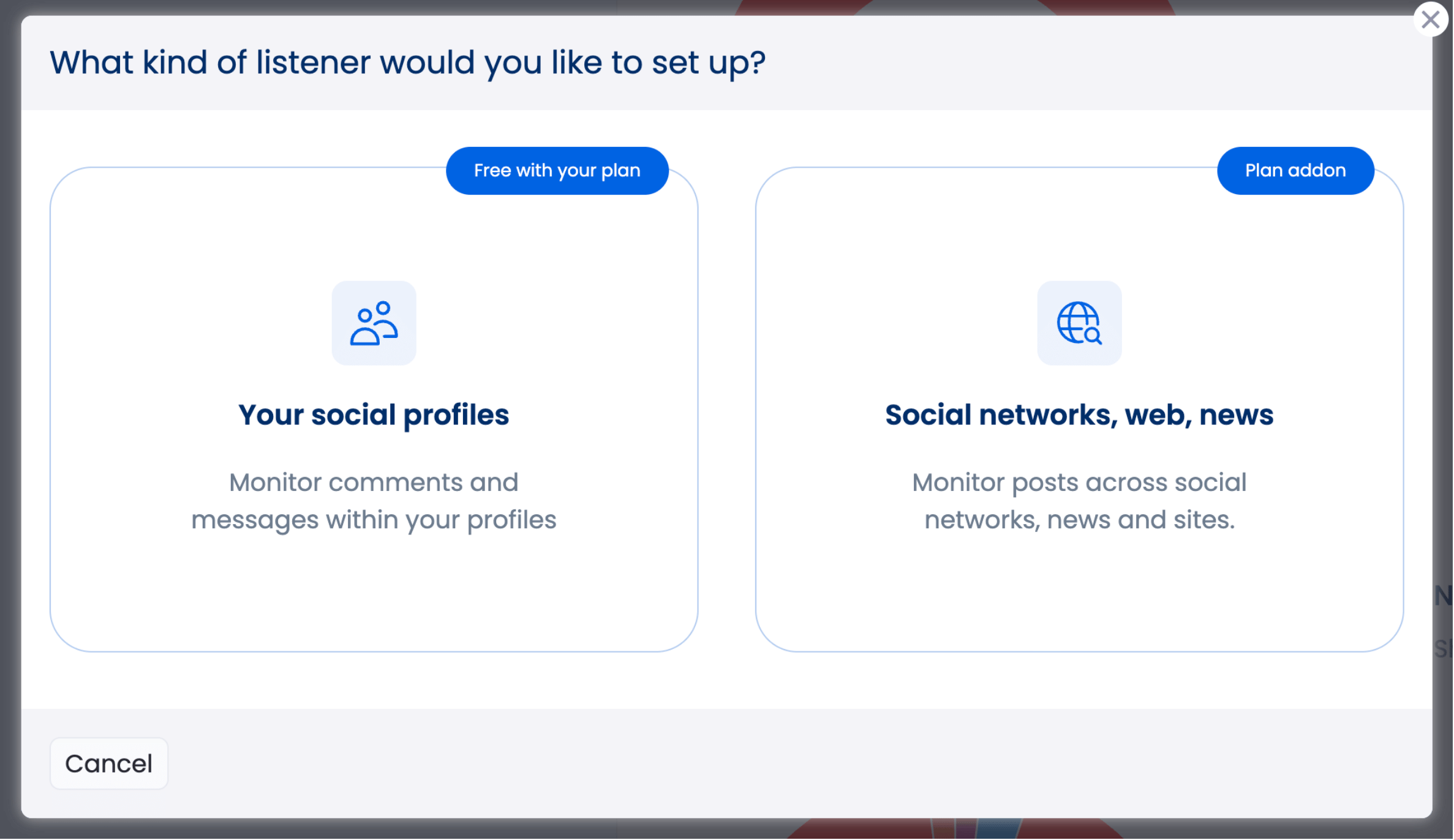
Step 2: Enter the name and description of your listener, sources, keywords, and advanced filters you’d like to implement.
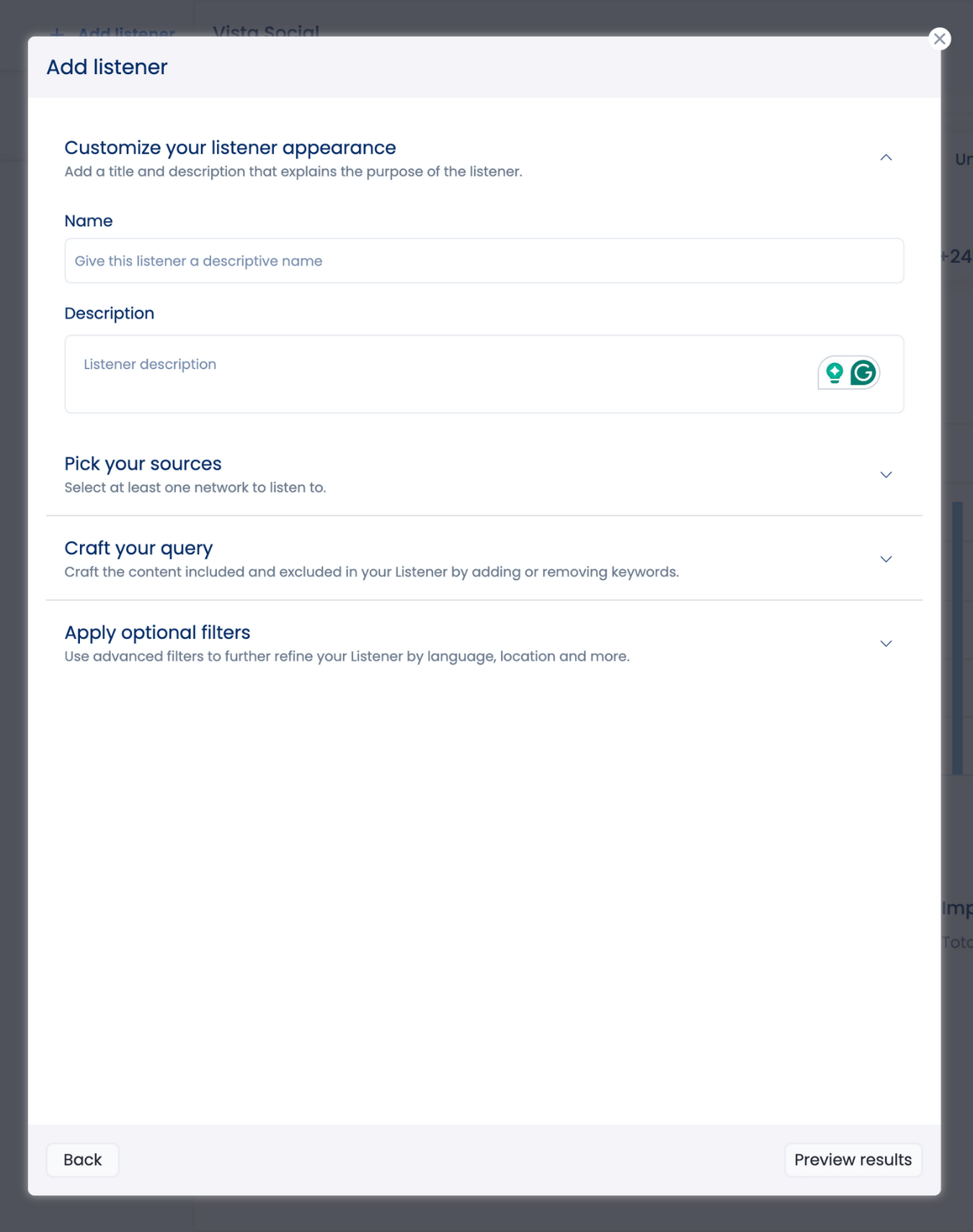
Step 3: Preview the results to see if you’re happy with the setup. Here’s an example of what this might look like.
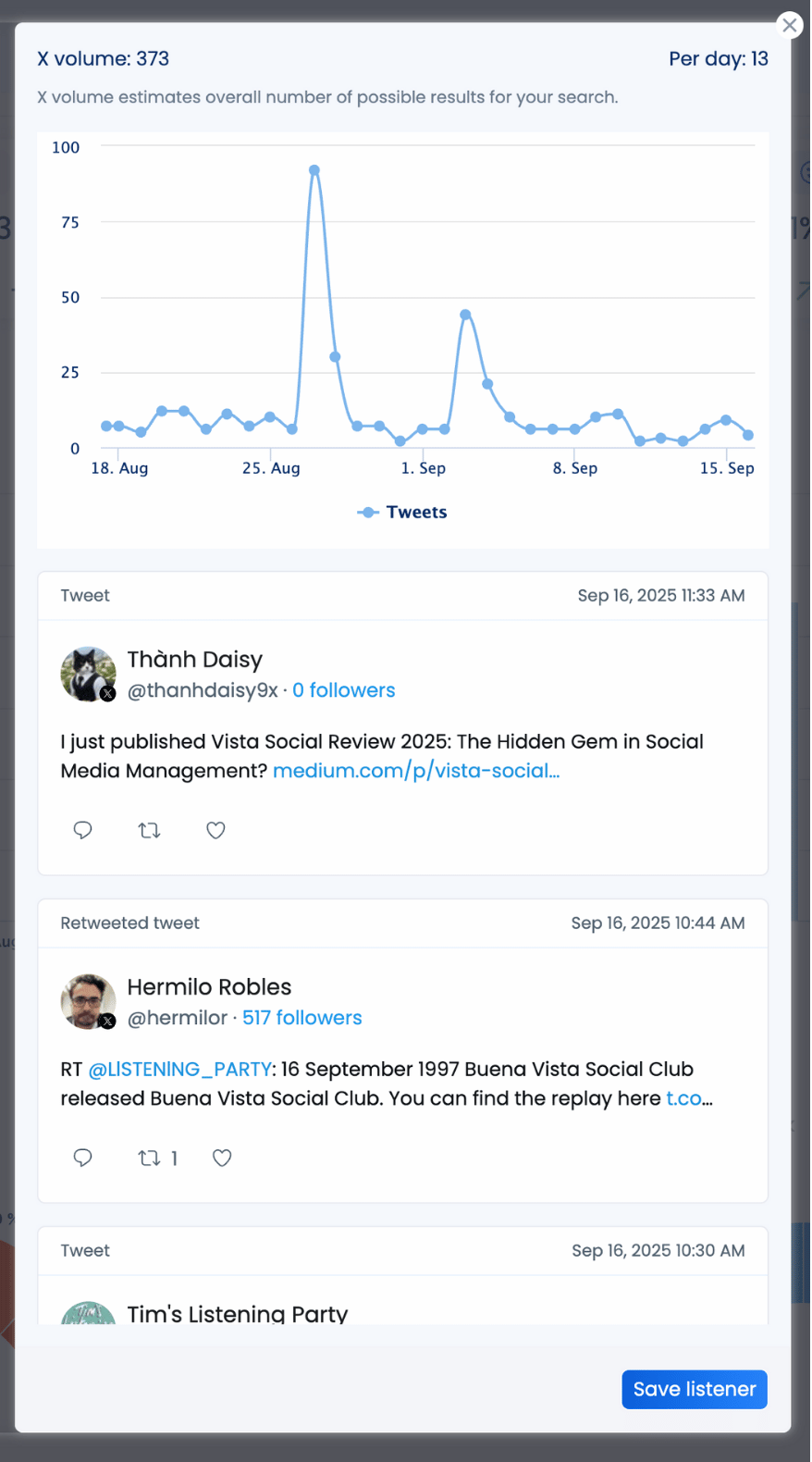
Step 4: Respond directly from the Unified Inbox to resolve issues quickly. This feature consolidates all comments and messages into one feed.
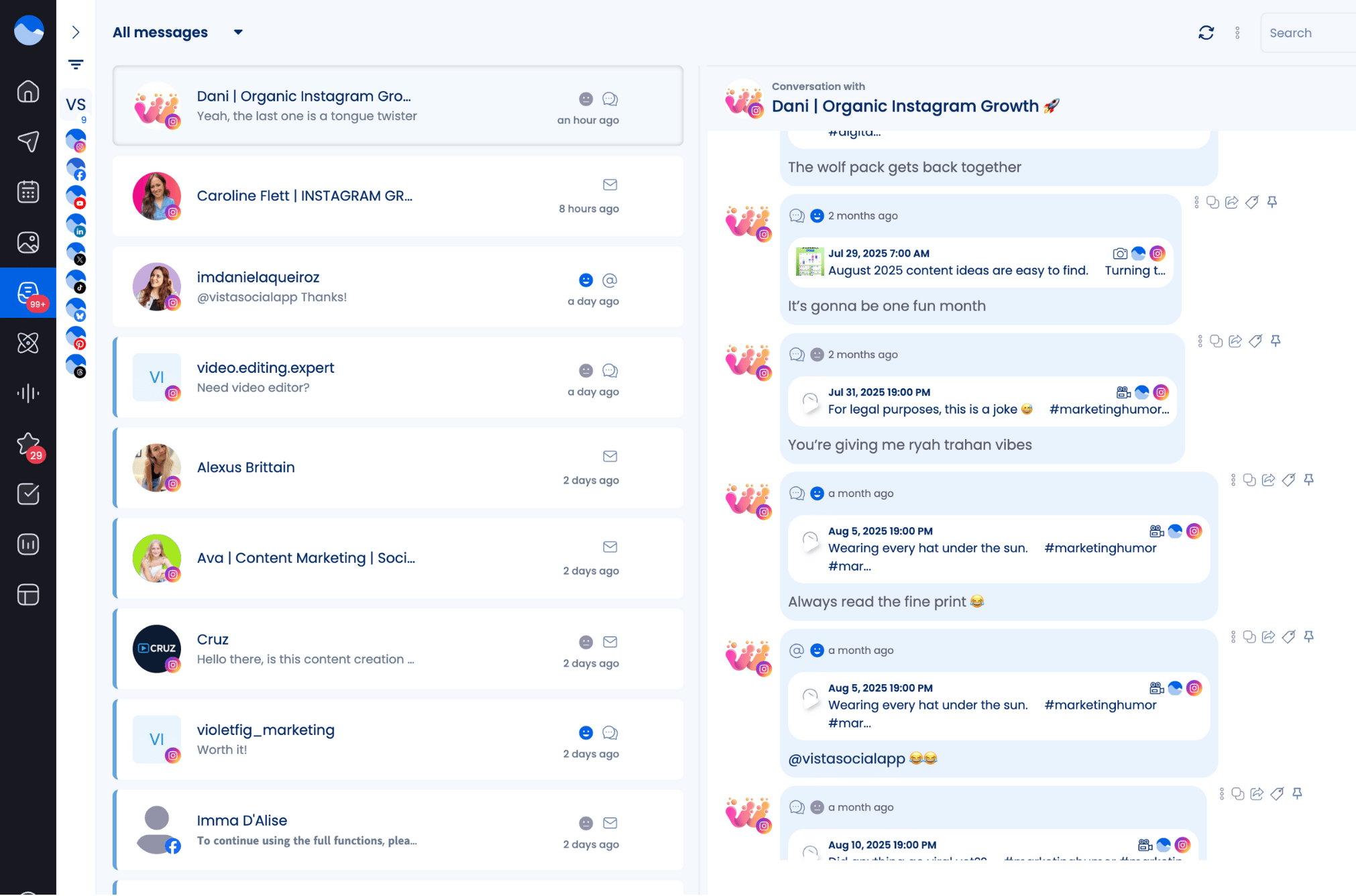
By monitoring and responding consistently, you build stronger relationships with your audience and protect your brand image.
Crisis management with social media intelligence
Every brand will face a crisis at some point. It might be a product issue, a customer complaint gone viral, or an industry controversy.
The speed of your response determines how much damage is done.
Social media intelligence is your early warning system. By setting up real-time monitoring for brand mentions, competitor activity, and industry keywords, you spot potential issues before they escalate.
For example, if negative sentiment spikes suddenly, that’s a signal to investigate. Maybe a dissatisfied customer’s post is gaining traction. Without monitoring, you’d only notice when it’s too late.
Vista Social’s Listening tools give you that visibility. You can preview results, apply filters, and get alerts for unusual activity. From there, the Unified Inbox ensures your team responds quickly and consistently.
Another best practice is to map response protocols in advance. Intelligence highlights the issue, but preparation dictates your response. Pre-define escalation paths for different scenarios so your team acts with confidence, not panic.
When handled well, crises can even build trust.
Customers notice when brands take responsibility, respond quickly, and resolve issues transparently. Social media intelligence turns a reactive moment into an opportunity to demonstrate credibility.
How to apply social media intelligence
Knowing the components is useful, but the real value comes from applying them. Anyone—from solo creators to established brands—can turn insights into action.
Improving campaign strategies
Campaign optimization is the first application. By reviewing which posts and formats perform best, you can replicate success and avoid wasted effort.
For instance, if you see that video content consistently outperforms static posts, you can shift resources to produce more video. Over time, these insights create a more efficient and effective content mix.
Strengthening reputation
Improving campaigns is only one piece. Social media intelligence also strengthens brand reputation through proactive monitoring.
Managing all mentions from a single inbox prevents delays in responding. Quick responses can turn negative interactions into positive outcomes and even build customer loyalty.
Enhancing reporting
Finally, insights need to be communicated clearly. Reporting ensures that decision-makers understand the ROI of your strategies.
Automated reports not only save time but also showcase progress in an easy-to-digest format. They make it simple to highlight wins, identify weak spots, and plan next steps with confidence.
Must Read:Mastering Social Media Analytics: How to Create Custom Reports
Advanced techniques for social media intelligence
Once you’ve applied the basics, it’s time to look at advanced methods. These techniques help uncover insights competitors might overlook and give you an edge in planning future campaigns.
Predictive analytics
Predictive analytics builds on reporting by using past performance to forecast future outcomes. This helps allocate budgets more effectively and prevents wasted ad spend.
Analytics platforms can highlight recurring trends, giving you the foresight to plan campaigns in advance. This kind of forecasting can mean the difference between leading the conversation or scrambling to catch up.
Competitor gap analysis
Forecasting naturally leads to competitor gap analysis. Once you know what’s coming, you can compare it against what competitors are doing.
Gap analysis makes weaknesses visible. You can use these findings to position your brand with unique strengths in the market, rather than chasing what others are already doing well.
Cross-platform performance tracking
Gap analysis then connects to performance tracking across platforms. Different audiences behave differently depending on where they interact.
Cross-channel dashboards reveal which networks need more investment and which are already delivering returns. With this knowledge, you can fine-tune your strategy to maximize impact.
The role of AI in social media intelligence
Cross-platform insights set the stage for AI-driven intelligence. Manual tracking isn’t enough to handle massive datasets across multiple channels.
AI tools process data faster and reveal patterns that would otherwise remain hidden. They also recommend actions based on trends, enabling teams to act proactively rather than reactively.
By integrating AI-driven features, you can automate the detection of sentiment and get content recommendations in real time. This gives you the ability to scale monitoring and content optimization without additional headcount.
Must Read: The Power of AI in Social Media Marketing in 2024
Expanding use cases for social media intelligence
As AI scales your monitoring, the applications expand across multiple areas of business. Intelligence can fuel growth in several ways and support both marketing and operations.
Influencer intelligence
One growing area is influencer intelligence. Partnerships are only valuable when influencers truly align with your audience.
Evaluating influencer engagement, sentiment, and reach ensures the right fit. This prevents wasted budget on mismatched collaborations and increases the likelihood of campaign success.
Employee advocacy
Influencer data connects naturally with employee advocacy. Employees can be authentic ambassadors who extend reach organically.
Social media intelligence helps measure the performance of advocacy posts. It also reveals which employees drive the highest engagement, enabling organizations to build stronger internal programs.
Industry-specific applications
Both influencers and employees tie into industry-specific needs. A retail brand, for instance, may prioritize trend tracking, while a SaaS brand focuses on sentiment analysis.
Customizable dashboards make it easier to adapt intelligence to different industries. This helps tailor insights instead of using one-size-fits-all solutions.
Use Vista Social to leverage social media intelligence
Social media intelligence is only powerful if you can act on it.
The right platform helps you move from scattered data to clear, actionable insights. Vista Social brings publishing, monitoring, reporting, and engagement into one streamlined workflow.
Instead of juggling multiple tools, you get everything you need to understand your audience, track sentiment, and refine strategy in real time.
Whether you’re a creator, business owner, or agency, Vista Social makes intelligence simple and accessible. Automated reports, listening tools, and unified inbox features save time while giving you clarity on what matters most.
Don’t just collect data—turn it into growth.
Sign up for a free Vista Social account today and start leveraging social media intelligence to make smarter, faster decisions.
Social media intelligence FAQ
What is the difference between social media analytics and social media intelligence?
Analytics tracks performance metrics. Intelligence interprets those metrics to guide strategy.
How does social media intelligence help businesses?
It provides data-driven insights to improve campaigns, monitor reputation, and deliver better reports.
What tools are best for social media intelligence?
Look for an all-in-one solution with publishing, analytics, monitoring, and reporting capabilities. Vista Social is one example.
Can AI improve social media intelligence?
Yes. AI processes large datasets quickly, surfaces hidden patterns, and enhances decision-making accuracy.
How do I start using social media intelligence?
Connect your accounts, set up monitoring, and begin tracking key metrics for actionable insights.
About the Author
Content Writer
Jimmy Rodela is a social media and content marketing consultant with over 9 years of experience, with work appearing on sites such as Business.com, Yahoo, SEMRush, and SearchEnginePeople. He specializes in social media, content marketing, SaaS, small business strategy, marketing automation, and content development.
Read with AI
Save time reading this article using your favorite AI tool
Summarize with AI
Never Miss a Trend
Our newsletter is packed with the hottest posts and latest news in social media.
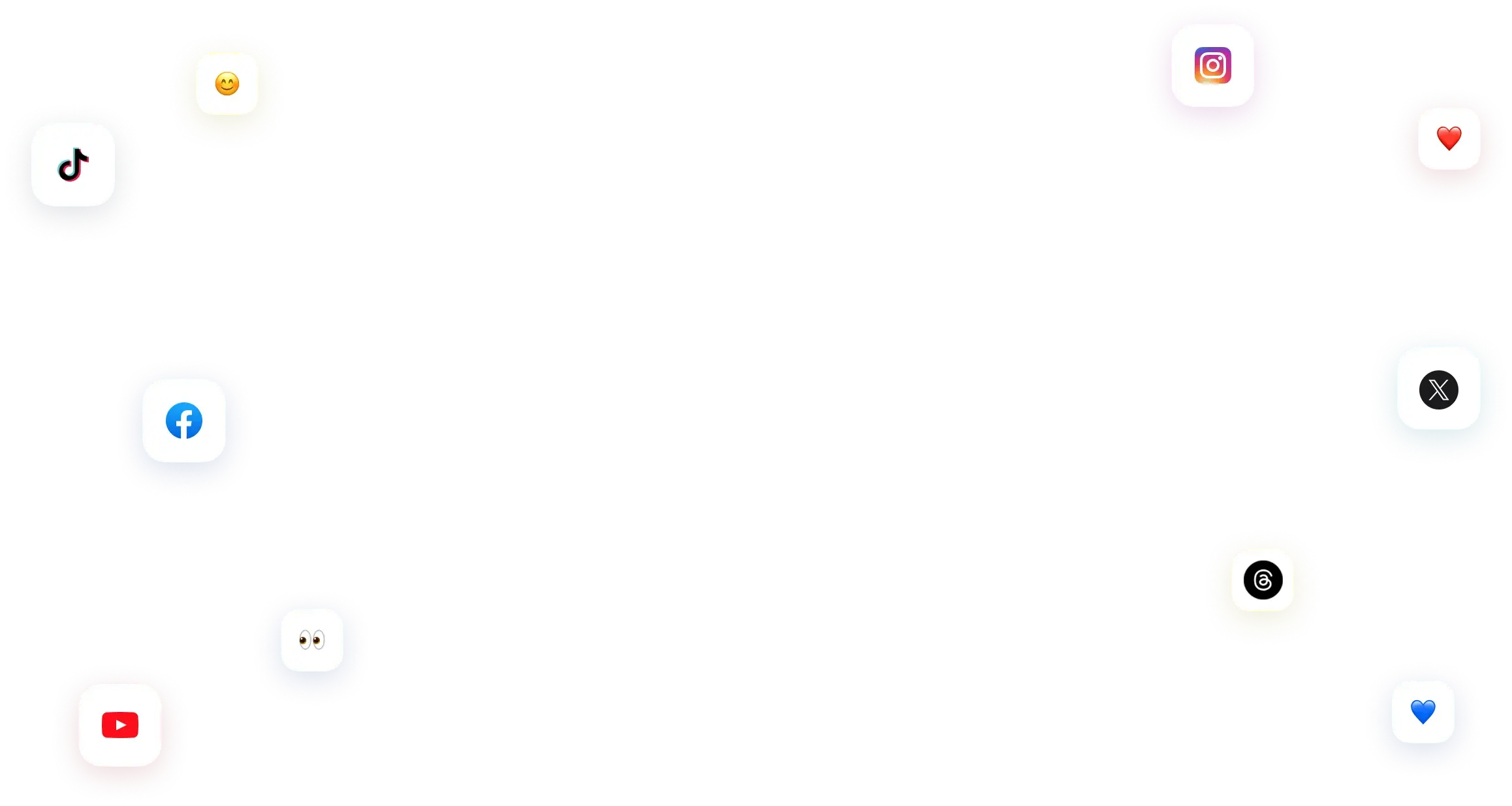
You have many things to do.
Let us help you with social media.
Use our free plan to build momentum for your social media presence.
Or skip ahead and try our paid plan to scale your social media efforts.
P.S. It will be a piece of cake 🍰 with Vista Social
Subscribe to our Newsletter!
To stay updated on the latest and greatest Social Media news. We promise not to spam you!


